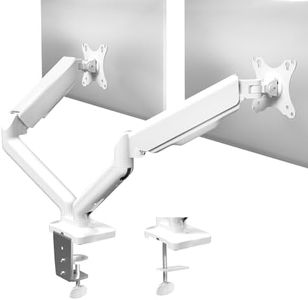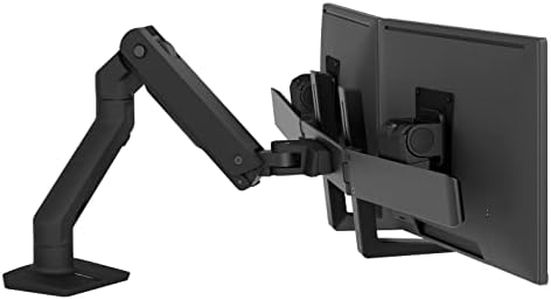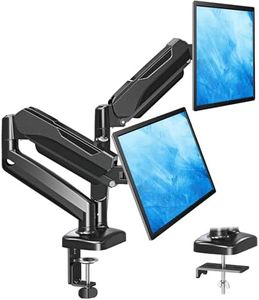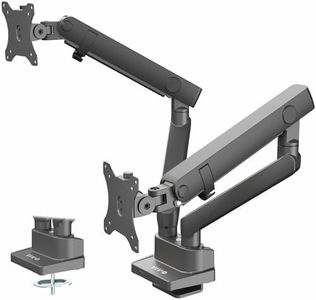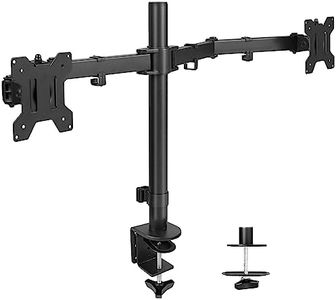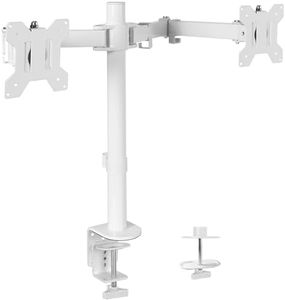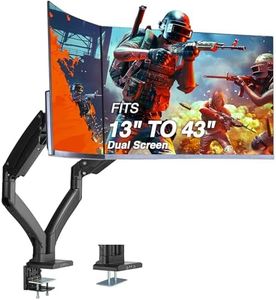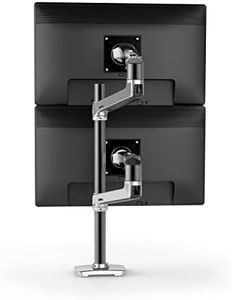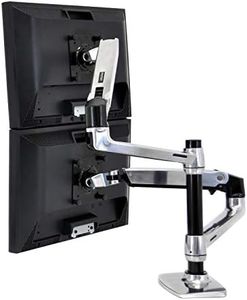We Use CookiesWe use cookies to enhance the security, performance,
functionality and for analytical and promotional activities. By continuing to browse this site you
are agreeing to our privacy policy
10 Best Dual Monitor Arms
From leading brands and best sellers available on the web.Buying Guide for the Best Dual Monitor Arms
Choosing the right dual-monitor arm can greatly improve both your comfort and your workflow, whether you’re working from home, gaming, or designing. The idea is to have your screens at an ergonomic height and position, freeing up desk space and reducing strain on your neck and eyes. To find the best one for your needs, you should think about the specifications that matter most for your desk setup and daily tasks.Monitor CompatibilityThis spec refers to the size (in inches) and weight (in kilograms or pounds) of monitors that the arms can support. It’s important to check this because using a monitor that’s too heavy or too large for the arm may result in instability or damage. Dual arms usually break down into ranges—some are for lightweight monitors up to 24 inches, others can handle large ultrawides up to 32 inches or more. Look at both the individual arm’s weight limit and the VESA mount size (usually 75x75mm or 100x100mm) to ensure your monitors will fit securely. Choose based on the size and weight of your monitors—if you plan to upgrade later, consider a more versatile arm.
AdjustabilityAdjustability covers how much movement the arm allows in terms of height, tilt, rotation, and swivel. This is vital for customizing your setup for the most comfortable and efficient work position. Some arms only offer simple height adjustments, while others allow for full 360-degree rotation, extensive tilt, and even extending monitors forward or to the side. If you need to switch between landscape and portrait mode or frequently reposition your monitors, look for arms with maximum flexibility. Otherwise, basic adjustability may be sufficient for static setups.
Mounting MethodMonitor arms typically attach to your desk using either a clamp or a grommet mount. Clamp mounts fasten to the edge of your desk and are easy to install and move, while grommet mounts require a hole in the desk for a more permanent, sturdy installation. The choice here will depend on your desk type, thickness, and whether you want a temporary or fixed setup. If you have a delicate or glass desk, make sure your desk can handle the clamp pressure or consider a compatible mounting method.
Cable ManagementMany dual-monitor arms feature built-in cable management systems, which help keep your workspace tidy by organizing and hiding monitor cables along the arms. This isn’t essential for function, but it can make your setup look neater, prevent tangled cables, and make cleaning easier. For users who value a clean look or work in shared or public spaces, picking an arm with strong cable management is recommended.
Arm Type (Spring, Gas, Static)Arms are generally categorized into gas spring, mechanical spring, and static/fixed types. Gas spring arms allow for smooth, effortless adjustments with minimal force and are ideal for frequent monitor repositioning. Mechanical springs offer adjustability but can require more effort and are less smooth. Static arms are simpler and often less expensive but offer limited adjustability. If you want quick, frequent adjustments or share your desk, gas spring arms are usually the best choice; otherwise, fixed arms might suit a more permanent position.
Build Quality and MaterialThe construction material of the arm, usually metal or heavy plastic, greatly influences durability, stability, and overall feel. Metal arms tend to be sturdier and support more weight but weigh more themselves and may cost more. Plastic components can be lighter but may feel less robust over time. If you value long-term reliability and use heavier monitors, prioritize arms made of good-quality metal.
